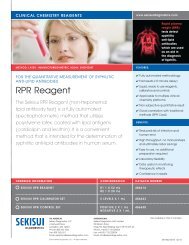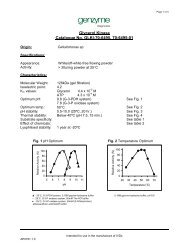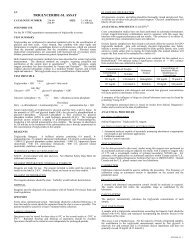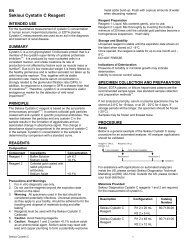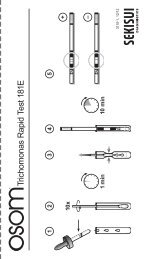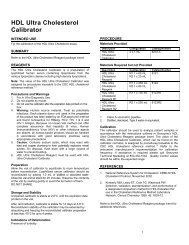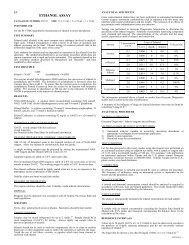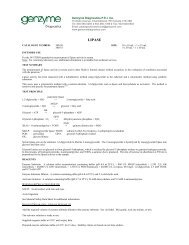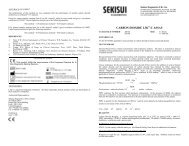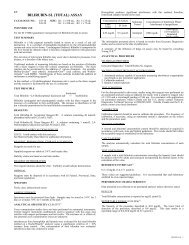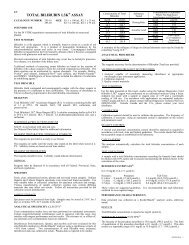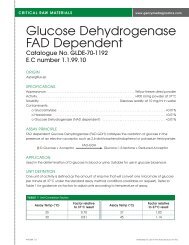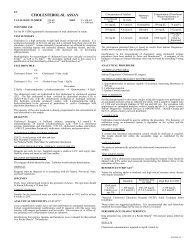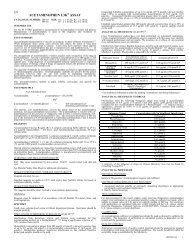IRON-SL ASSAY - Sekisui Diagnostics
IRON-SL ASSAY - Sekisui Diagnostics
IRON-SL ASSAY - Sekisui Diagnostics
- No tags were found...
Create successful ePaper yourself
Turn your PDF publications into a flip-book with our unique Google optimized e-Paper software.
ENANALYTICAL SPECIFICITY (CLSI EP7)<strong>IRON</strong>-<strong>SL</strong> <strong>ASSAY</strong>(11)CATALOGUE NUMBER: 157-30 SIZE: R1: 3 x 100 mL, R2: 1 x 75 mLINTENDED USEFor the IN VITRO quantitative measurement of iron in serum.TEST SUMMARYIron measurements are used in the diagnosis and treatment of diseases andconditions such as iron deficiency anemia, hemochromatosis (characterized by aprogressive increase in iron stores leading to organ impairment), chronicinflammatory disorders, hepatitis, and lead poisoning (1) .Various photometric methods have been used to measure serum iron. In 1970Stookey (2) reported the synthesis of 3-(2-pyridyl)-5,6-bis(4-phenylsulfonic acid)-1,2,4-triazine, monosodium salt (Ferrozine ® ) which complexed with ferrous ironto form a tris ferrozine/iron, Fe(Fz) 3 complex. An additional ferroin type Concentration of Analytecompound called 5,5'(3-(2-pyridyl)-1,2,4-triazine-5,6 diyl)-bis-2-furansulfonicSubstanceacid, disodium salt (Ferene ® ) has become available (3,4,5) and is used in this reagent. ConventionalTestedFerene ® is a superior iron chelating agent forming a tris complex with ferrous iron UnitsSI Unitswith a maximum absorption at 593 nm and a molar absorptivity of 35,500. Thecompound has a 27% higher molar absorption than ferrozine, absorbs at a longerwavelength and has the other advantages of ferrozine; namely, its solubility andstability over the pH range 4-9.TEST PRINCIPLEAscorbic AcidTransferrin (Fe +++ ) 2 2 Fe ++ + Transferrin IBufferFe ++ + 3 Ferene Ferrous Ferene (blue complex) IIIn an acidic medium transferrin bound iron dissociates into ferric ions which arereduced to ferrous ions in the presence of ascorbic acid. The ferrous iron reactswith the chromogen Ferene ® to form a blue chromophore which absorbs at 595nm. The absorbance is directly proportional to the serum iron concentration.ANALYTICAL PROCEDUREREAGENTSMATERIALS PROVIDEDIron-<strong>SL</strong> Acid Dissociating Reagent (R1): A buffer solution (pH 4.5 at 25C) <strong>Sekisui</strong> <strong>Diagnostics</strong>’ Iron-<strong>SL</strong> reagents.containing a surfactant, preservatives, and stabilizers.MATERIALS REQUIREDIron-<strong>SL</strong> Color Reagent (R2): A solution containing 6 mmol/L ferene andstabilizers.Iron Calibrator (for manual assay only): 1 x 10 mL of a solution containing 195µg/dL (35 µmol/L) iron (included with 157-10 and 157-30 only).WARNINGS AND PRECAUTIONS FOR USETEST CONDITIONSS24/25: Avoid contact with skin and eyes.See Material Safety Data Sheet for additional information.REAGENT PREPARATION, STORAGE AND STABILITYReagents and calibrator are ready to use.The reagents and calibrator included are stable until the expiry date stated on the CALIBRATIONlabels at 2-8C. The R2 Color Reagent should be protected from light.Stability claims are based on real time studies.REAGENT DETERIORATIONQUALITY CONTROLThe reagent solutions should be clear. Turbidity would indicate deterioration.DISPOSALlaboratory.Reagents must be disposed of in accordance with all Federal, Provincial, State, CONTROL SERUM.and local regulations.CALCULATIONSSPECIMENFreshly drawn, clear, unhemolysed serum from fasting patients is the specimen ofchoice. Avoid anticoagulants. Serum should be separated from the cells promptly TEST LIMITATIONSto minimize hemolysis. It is recommended that specimen collection be carried outin accordance with CLSI document H4. (11)GLASSWARE PREPARATIONAll glassware and equipment used in an iron assay must be free of contaminating REFERENCE INTERVALS (10)iron. Glassware may be prepared by soaking overnight in 1 N HCl or sulfuricacid-dichromate cleaning solution. If stronger concentrations of HCl are used, the Male: 65-170 µg/dL (11.6-30.4 µmol/L)time necessary for decontamination may be decreased. The glassware should be Female: 50-170 µg/dL (8.9-30.4 µmol/L)rinsed with deionized water before it is used.SAMPLE STORAGESerum iron is reported to be stable for 4 days at 18-26C or 7 days at 2-8C. (6)Cross Contamination studies have not been performed on automated instruments.Certain reagent / instrument combinations used in sequence with this assay mayinterfere with reagent performance and test results. The existence of, or effects of,any potential cross contamination issues are unknown.Copper is the only cation of the trace metals normally present in serum capable offorming a colored complex with ferene. Copper interference with ferene is similarto that encountered with ferrozine and studied by Duffy and Gaudin (7) . Ninetyfivepercent of the copper interference is eliminated by chelation of free copper.Sera obtained from patients receiving heparin for therapy (for example,Hemodialysis) may recover falsely high results with Iron-<strong>SL</strong> reagent. (9)Interferences from icterus, lipemia and hemolysis were evaluated for this ironmethod on a Roche/Hitachi ® analyzer using a significance criterion of >10%variance from control. Interference data was collected in serum.Concentration of InterferentWhere Interference isInsignificant73 μg/dL 13.1 μmol/L Hemoglobin 100 mg/dL 15.5 μmol/L75 μg/dL 13.4 μmol/L Bilirubin 40 mg/dL 684 μmol/L69 μg/dL 12.4 μmol/L Intralipid 1000 mg/dL3000 mg/dL(33.9 mmol/L)SimulatedTriglyceridesThe information presented above is based on results from <strong>Sekisui</strong> <strong>Diagnostics</strong>’studies and is current at the date of publication.A summary of the influence of drugs on clinical laboratory tests may be found byconsulting Young, D.S. (8)1. Automated analyzer capable of accurately measuring absorbance at appropriatewavelengths as per instrument application.2. Calibration material.3. Quality Control materials.For the data presented in this insert, studies using this reagent were performed onan automated analyzer using an endpoint test mode, with a sample to reagent ratioof 1:15.3 and a wavelength reading of 600/700 nm. For assistance withapplications on automated analyzers within Canada and the U.S., please contact<strong>Sekisui</strong> <strong>Diagnostics</strong> Technical Services at (800)565-0265. Outside Canada andthe U.S., please contact your local distributor.Calibration material should be used to calibrate the procedure. The frequency ofcalibration using an automated system is dependent on the system and theparameters used. A serum based calibrator is required for automated systems.A normal and abnormal concentration control should be analyzed as required.The results should fall within the acceptable range as established by theNOT INTENDED FOR USE WITH BOVINE BASEDThe analyzer automatically calculates the iron concentration of each sample.A sample with an iron concentration exceeding the linearity limit should bediluted with 0.9% saline and reassayed incorporating the dilution factor in thecalculation of the value.These values are suggested guidelines. It is recommended that each laboratoryestablish the normal range for the area in which it is located. Serum ironconcentrations show a diurnal variation with peak values seen in the earlymorning.PERFORMANCE CHARACTERISTICSData presented was collected on a Roche/Hitachi ® analyzer unless otherwisestated.(IN15710-15) 1
RESULTSIron concentration is reported as µg/dL (µmol/L).REPORTABLE RANGE (CLSI EP6) (11)The linearity of the procedure described is 1000 µg/dL (179 µmol/L). The lowerlimit of detection of the procedure described is 8 µg/dL (2 µmol/L). This dataresults in a reportable range of 8-1000 µg/dL (2-179 µmol/L).PRECISION STUDIES (CLSI EP5) (11)Total precision data was collected on two concentrations of control sera in 40 runsconducted over 20 days.Concentration Total SDTotalWithin Run SDCVµg/dL µmol/L µg/dL µmol/L % µg/dL µmol/LWithinRun CV%84 15 1.4 0.25 1.6 0.7 0.13 0.8277 50 3.0 0.54 1.1 1.0 0.18 0.3ACCURACY (CLSI EP9) (11)The performance of this method (y) was compared with the performance of asimilar commercially available method (x) on a Roche/Hitachi ® analyzer. Fortyfivepatient serum samples ranging from 9-288 µg/dL (2-52 µmol/L) gave acorrelation coefficient of 0.9995. Linear regression analysis gave the followingequation:This method = 1.00 (reference method) - 5 µg/dL (1 µmol/L).The information presented above is based on results from <strong>Sekisui</strong> <strong>Diagnostics</strong>studies and is current at the date of publication.TRADEMARKSAll trademarks, brands, product names and trade names are the property of theirrespective companies.Manufactured by:The AmericasInternational<strong>Sekisui</strong> <strong>Diagnostics</strong> P.E.I. Inc.<strong>Sekisui</strong> <strong>Diagnostics</strong> (UK) Limited70 Watts Avenue 50 Gibson DriveCharlottetown, PE C1E 2B9Kings Hill, West MallingCanadaKENT, ME19 4AF, UKPhone: 800-565-0265Email: info@sekisuidiagnostics.comFax: 902-628-6504Email: questions@sekisuidiagnostics.compeidiagnostictechnical@sekisuidiagnostics.comwww.sekisuidiagnostics.comESANALISIS DE HIERRO-<strong>SL</strong>NÚMERO DETAMAÑO:CATÁLOGO: 157-30 R1: 3 x 100 ml, R2: 1 x 75 mlUSO PARA EL QUE FUE DISEÑADOPara la medición cuantitativa IN VITRO de hierro en suero.RESUMEN DEL ANÁLISISIron Las mediciones se utilizan en el diagnóstico y tratamiento de enfermedades yafecciones como anemia por deficiencia de hierro, hemocromatosis (que secaracteriza por un aumento progresivo en la acumulación de hierro que provoca eldeterioro de los órganos), afecciones inflamatorias crónicas, hepatitis yenvenenamiento por plomo (1) .Para la medición del hierro en suero se han utilizado diversos métodosfotométricos. En 1970, Stookey (2) dio a conocer los resultados de la síntesis de 3-(2-piridil)-5,6-bis(4-ácido fenilsulfónico)-1,2,4-triazina, sal monosódica(Ferrozine ® ) que se combina con hierro ferroso para formar un complejo trisferrozina/hierro,Fe(Fz) 3 . Existe un compuesto adicional de tipo ferroína,denominado 5,5'(3-(2-piridil)-1,2,4-triazina-5,6 diil)-bis-2-ácido furansulfónico,sal disódica (Ferene ® ) (3,4,5) que se utiliza en este agente reactivo. Ferene ® es unagente quelante superior de hierro que forma un complejo tris con el hierro ferrosocon una absorción máxima de 593 nm y una absorbencia molar de 35,500. Elcompuesto tiene una absorción molar mayor en un 27% que la ferrozina, seabsorbe a una longitud de onda más larga y tiene las otras ventajas de la ferrozina;es decir, su solubilidad y estabilidad sobre la gama de pH de 4 a 9.PRINCIPIO DEL ANÁLISISÁcido ascórbicoTransferrina (Fe +++ ) 2 2 Fe ++ + Transferrina ITampónFe ++ + 3 Ferene Ferene ferroso (complejo azul) IIEn un medio acídico, el hierro unido a la transferrina se disocia en iones férricosque son reducidos a iones ferrosos en presencia del ácido ascórbico. El ionferroso reacciona con el cromógeno Ferene ® para formar un cromóforo azul que seabsorbe a 595 nm. La absorbencia es directamente proporcional a laconcentración del hierro en suero.AGENTES REACTIVOSAgente reactivo de disociación de ácido Hierro-<strong>SL</strong> A(R1): Una solución tampón(pH 4.5 a 25C) que contiene un agente tensioactivo, agentes conservantes yestabilizadores.Agente reactivo de color Hierro-<strong>SL</strong> (R2): Una solución que contiene 6 mmol/l deFerene y agentes estabilizadores.Calibrador de hierro (para estudios manuales únicamente): 1 x 10 ml de unasolución que contiene 195 µg/dl (35 µmol/l) de hierro (incluida sólo con 157-10 y157-30).ADVERTENCIAS Y MEDIDAS DE PRECAUCIÓN PARA SU USOS24/25: Evite el contacto con la piel y los ojos.Para obtener mayor información, lea la hoja de datos de seguridad de materiales.PREPARACIÓN, ALMACENAMIENTO Y ESTABILIDAD DEL AGENTEREACTIVOReagents y el calibrador vienen listos para su uso.Los agentes reactivos y el calibrador que vienen incluidos son estables hasta lafecha de vencimiento indicado en las etiquetas, a una temperatura de 2 a 8C. Elagente reactivo de color R2 debe ser protegido contra la luz.Las afirmaciones acerca de la estabilidad se fundan en estudios a tiempo real.DETERIORO DEL AGENTE REACTIVOLas soluciones del agente reactivo deben ser transparentes. La turbidez podría seruna indicación de deterioro.ELIMINACIONLos agentes reactivos se deben eliminar de acuerdo con las estipulaciones de lasnormas federales, provinciales, estatales y locales.MUESTRALa muestra de preferencia es la del suero recién sacado, transparente, sinhemolizar, de pacientes en ayuno. Evite los anticoagulantes. Para minimizar lahemólisis, debe separarse rápidamente el suero de las células. Se recomienda quela recolección de muestras se realice de acuerdo con el documento H4 (11) de CLSI.(IN15710-15) 2
PREPARACIÓN DE LOS ARTÍCULOS DE VIDRIOTodos los artículos de vidrio y equipos utilizados en los estudios sobre el hierrodeben estar limpios de hierro contaminante. Los artículos de vidrio deben serpreparados sumergiéndolos durante la noche en una solución de limpieza de NHCl o ácido sulfúrico-dicromato. Si se emplea una concentración más fuerte deHCl, puede reducirse el tiempo necesario para el proceso de descontaminación.Los artículos de vidrio deben ser enjuagados con agua desionizada antes deusarlos.ALMACENAMIENTO DE LAS MUESTRASExisten informes que señalan que el hierro en suero es estable durante cuatro días,a una temperatura de entre Serum 18 y 26C, o 7 días a una temperatura de entre 2y 8C. (6)ESPECIFIDAD ANALÍTICA (CLSI EP7) (11)No se ha realizado estudios acerca de la contaminación cruzada en instrumentosautomatizados. Ciertas combinaciones de agentes reactivos/instrumentosutilizados en secuencia con este estudio pueden interferir con el desempeño de losagentes reactivos y los resultados de los análisis. Se desconoce si existenproblemas de contaminación cruzada posible, o de sus efectos.El cobre es el único catión de los metales traza que normalmente se encuentranpresentes en el suero, y que es capaz de formar un complejo coloreado con Ferene.La interferencia del cobre con Ferene es similar a la que se produce con Ferroziney que ha sido estudiada por Duffy y Gaudin (7) . Un noventa y cinco por ciento dela interferencia de cobre se elimina mediante la quelatación del cobre libre.El suero obtenido de pacientes a los que se les ha administrado heparina (porejemplo, para hemodiálisis) puede producir resultados elevados falsos con elagente reactivo hierro-<strong>SL</strong>. (9)Para este método de análisis del hierro, se evaluó la interferencia producida por laictericia, la presencia de lípidos en la sangre y la hemólisis, en un analizadorRoche/Hitachi ® , aplicando un criterio de relevancia de menos de un 10% dedesviación de la media de control. Los datos de interferencia se recogieron ensuero.Concentración del analizadoUnidadesconvencionalesUnidadesdel SISubstanciaanalizadaConcentración deinterferente en casos enque la interferencia esinsignificante73 μg/dl 13.1 μmol/l Hemoglobina 100 mg/dl 15.5 μmol/l75 μg/dl 13.4 μmol/l Bilirrubina 40 mg/dl 684 μmol/l69 μg/dl 12.4 μmol/l Intralipid 1000 mg/dl3000 mg/dl(33.9mmol/l) detriglicéridossimuladosLa información que se presenta arriba se funda en los resultados de los estudiospracticados por <strong>Sekisui</strong> <strong>Diagnostics</strong>, y vigente a la fecha de su publicación.Se puede obtener un resumen de la influencia de los medicamentos en estudiosclínicos de laboratorio consultando a Young, D.S. (8)PROCEDIMIENTO ANALÍTICOMATERIALES SUMINISTRADOSAgentes reactivos hierro-<strong>SL</strong> de <strong>Sekisui</strong> <strong>Diagnostics</strong>.MATERIALES NECESARIOS1. Analizador automatizado, capaz de medir con precisión la absorbencia a unalongitud de onda adecuada, según la aplicación por instrumento.2. Material de calibración.3. Materiales para el control de calidad.CONDICIONES DEL ANALISISPara la obtención de los datos que se presentan en este encarte, se realizaronestudios con este agente reactivo en un analizador automatizado en modo deanálisis de punto final, con una proporción de 1:15.3 entre la muestra y el agentereactivo, y una lectura de longitud de onda de 600/700 nm. Si desea ayuda paraaplicaciones en analizadores automatizados en Canadá o EE UU, comuníquesecon <strong>Sekisui</strong> <strong>Diagnostics</strong> Technical Services llamando al teléfono (800) 565-0265.En otros países, llame al distribuidor de su localidad.CALIBRACIONPara calibrar el procedimiento, debe emplearse el material de calibración. Lafrecuencia de la calibración utilizando un sistema automatizado depende delsistema y de los parámetros aplicados. Para los sistemas automatizados senecesita un calibrador en base a suero.CONTROL DE CALIDADDebe analizarse, según sea necesario, un control de concentración normal yanormal. Los resultados deben estar dentro de los límites aceptables establecidospor el laboratorio. ESTE PRODUCTO NO HA SIDO DISEÑADO PARAEMPLEARLO CON SUEROS DE CONTROL DE ORIGEN BOVINO.CALCULOSEl analizador calcula automáticamente la concentración de hierro de cada muestra.LIMITACIONES DEL ANÁLISISDebe diluirse con una solución salina al 0.9% y volver a analizarse las muestrascon una concentración de hierro que supere el límite de linealidad, teniendo encuenta el factor de dilución en el cálculo del valor.INTERVALOS DE REFERENCIA (10)Hombres: 65-170 µg/dl (11.6-30.4 µmol/l)Mujeres: 50-170 µg/dl (8.9-30.4 µmol/l)Estos valores se sugieren como pauta. Se recomienda que cada laboratorioestablezca los límites normales para el lugar en que está ubicado. Laconcentración de hierro en suero muestra fluctuaciones durante el día, y alcanzasus valores máximos temprano por la mañana.CARACTERÍSTICAS DE LOS RESULTADO<strong>SL</strong>os datos que aquí se presentan fueron recogidos empleando un analizador Roche/Hitachi ® , salvo que se indique lo contrario.RESULTADO<strong>SL</strong>a concentración de hierro está expresada en µg/dl (µmol/l).LIMITES SIGNIFICATIVOS (CLSI EP6) (11)La linealidad del procedimiento descrito es de 1000 µg/dl (179 µmol/l). El límiteinferior de detección del procedimiento descrito es de 8 µg/dl (2 µmol/l). Estosdatos caen dentro de los límites significativos de entre 8 y 1000 µg/dl (2-179µmol/l).ESTUDIOS DE PRECISION (CLSI EP5) (11)Los datos de precisión total fueron recogidos con dos muestras de concentraciónen suero de control, en cuarenta pruebas realizadas en un período de más de 20días.Concentración Total de SDDentro de laTotal prueba con SDde CVµg/dl µmol/l µg/dl µmol/l % µg/dl µmol/lDentro dela pruebacon CV%84 15 1.4 0.25 1.6 0.7 0.13 0.8277 50 3.0 0.54 1.1 1.0 0.18 0.3PRECISION (CLSI EP9) (11)The Los resultados de este método de análisis (y) se compararon con los de unmétodo de análisis similar que se puede adquirir del mercado (x), empleando unanalizador Roche/Hitachi ® . El análisis de las muestras de suero de cuarenta ycinco pacientes, con límites de entre 9 y 288 µg/dl (2-52 µmol/l) dio uncoeficiente de correlación de 0.9995. El análisis de regresión lineal dio lasiguiente ecuación:Este método = 1.00 (método de referencia) - 5 µg/dl (1 µmol/l).La información que se presenta arriba se funda en los resultados de los estudiospracticados por <strong>Sekisui</strong> <strong>Diagnostics</strong> y está vigente a la fecha de su publicación.MARCAS DE COMERCIOTodas las marcas de fábrica, marcas, nombres de productos y nombrescomerciales son de propiedad de sus respectivas empresas.Elaborado por:Continente americanoInternacional<strong>Sekisui</strong> <strong>Diagnostics</strong> P.E.I. Inc.<strong>Sekisui</strong> <strong>Diagnostics</strong> (UK) Limited70 Watts Avenue 50 Gibson DriveCharlottetown, PE C1E 2B9Kings Hill, West MallingCanadaKENT, ME19 4AF, RUTeléfono: 800-565-0265Correo electrónico:Fax: 902-628-6504info@sekisuidiagnostics.comCorreo electrónico:questions@sekisuidiagnostics.compeidiagnostictechnical@sekisuidiagnostics.comwww.sekisuidiagnostics.com(IN15710-15) 3
Definitions for Symbols/ Definición de los SímbolosThis product fulfills the requirements of the European Directive for In VitroDiagnostic Medical Devices.Este producto satisface los requisitos de la Directiva Europea para dispositivosmédicos para el diagnóstico in vitro.Batch CodeCódigo de loteManufacturerFabricanteConsult instructions for useConsulte las instrucciones de usoIn vitro diagnostic medical deviceDispositivo médico para el diagnóstico in vitroUse byYYYY-MM-DD or YYYY-MMFecha de caducidadAAAA-MM-DD o AAAA-MMREFERENCES/ REFERENCIAS1. Burtis, Carl A., Ashwood, Edward R. (Ed), Tietz Textbook of ClinicalChemistry, segunda edición, W.B. Saunders Company, Filadelfia, Londres,Toronto, Montreal, Sidney, Tokio, p. 2062, 1994.2. Stookey, L.L., Ferrozine - A New Spectrophotometric Reagent for Iron,Anal. Chem. 42, 779 (1970).3. Artiss, J.D., Vinogradov, S., Zak, B., Spectrophotometric Study of SeveralSensitive Reagents for Serum Iron, Clin. Biochem. 14, 311-315 (1981).4. Higgins, T., Novel Chromogen for Serum Iron Determinations, Clin. Chem.27, 1619 (1981).5. Artiss, J.D., Strandbergh, D.R., Zak, B., Study of Continuous FlowAutomation for Serum Iron on Comparing Several Sensitive Reagents.Microchemical Journal, 28, 275-284 (1983).6. Weissman, N., Pileggi, VJ, In Clinical Chemistry Principles and Technics,2a ed., R.J. Henry, D.C. Cannon, J.W. Winkelman, Editors, Harper & Row,Hagerstown (MD), 1974, pg. 684, 685, 695.7. Duffy, J.R., Gaudin, J., Copper Interference in the Determination of Iron inSerum Using Ferrozine, Clin. Biochem. 10, 122-123 (1977).8. Young, D.S., Effects of Drugs on Clinical Laboratory Tests, AACC Press,tercera edición, Washington, 1990.9. Bunting, Peter S., Aggarwal, Mahesh, Interference from Renal DialysisPatients’ Specimens in a Direct Method for Serum Iron, Clin. Chem. 29/6,1106-1108 (1983).10. Burtis, Carl A., Ashwood, Edward R. (Ed), Tietz Textbook of ClinicalChemistry, segunda edición, W.B. Saunders Company, Filadelfia, Londres,Toronto, Montreal, Sidney, Tokio, p. 2195, 1994.11. CLSI Method Evaluation Protocols, Clinical and Laboratory StandardsInstitute, Wayne, PA.Authorized Representative/ Representante autorizado:<strong>Sekisui</strong> <strong>Diagnostics</strong> (UK) Limited50 Gibson DriveKings Hill, West MallingKent, ME19 4AFUnited KingdomTel (+44)(0)1732-220022Fax (+44)(0)1732-220024IN15710-15November 15, 2013Catalog numberNúmero de catálogoAuthorized representativeIn the European CommunityRepresentante autorizado en la Comunidad EuropeaTemperature limitationLímites de temperatura(IN15710-15) 4



